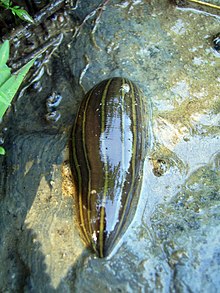Hirudo
| Hirudo | |
|---|---|

| |
| Scientific classification | |
| Domain: | Eukaryota |
| Kingdom: | Animalia |
| Phylum: | Annelida |
| Clade: | Pleistoannelida |
| Clade: | Sedentaria |
| Class: | Clitellata |
| Subclass: | Hirudinea |
| Order: | Arhynchobdellida |
| Family: | Hirudinidae |
| Genus: | Hirudo Linnaeus, 1758 |
| Type species | |
| Hirudo medicinalis[1] Linnaeus, 1758
| |
Hirudo is a genus of leeches of the family Hirudinidae. It was described by Carl Linnaeus in his landmark 1758 10th edition of Systema Naturae.[2]
The two well-accepted species within the genus are:[3]
- Hirudo medicinalis Linnaeus, 1758
- Hirudo nipponia Whitman, 1886
Three other species, previously synonymized with H. medicinalis, were described in 2005 and are gaining acceptance:[3][4][5]
Description
Species are typically exterior feeders. They have jaws that typically consist of about 60 teeth and do not possess papillae.[6]
Distribution
Hirudo medicinalis: Britain and southern Norway to the southern Urals, probably as far as the Altai Mountains (the deciduous arboreal zone)[7]
Hirudo verbana: Switzerland and Italy to Turkey and Uzbekistan (the Mediterranean and sub-boreal steppe zone)[7]
Hirudo orientalis: Transcaucasian countries, Iran, and Central Asia (mountainous areas in the sub-boreal eremial zone)[7]
Hirudo sulukii: Kara Lake of Adiyaman, Sülüklü Lake of Gaziantep and Segirkan wetland of Batman in Turkey[5]
Hirudo troctina: North-western Africa and Spain (Mediterranean zone)[7]
Hirudo nipponia: East Asia, including Far East district in Russian, Japan, Korea, China, Mongolia, Ryukyu Islands and Taiwan[8]
Hirudo tianjinensis: China [9]
Hirudo verbana is further divided into nonoverlapping eastern and western phylogroups.[10]
Medical use
While H. medicinalis has long been used in hirudotherapy, and is approved by the US FDA as a prescription medical device, a 2007 study employing genetic analysis found that the species being marketed as H. medicinalis, possibly for decades, was the recently distinguished H. verbana.[11]
Conservation status
A 2010 study of data gathered four species proposed an IUCN status of near threatened for H. medicinalis, H. verbana, and H. orientalis, and a status of data deficient for H. troctina.[7]
References
- ^ International Commission on Zoological Nomenclature (1922). "Opinion 75. Twenty-Seven Generic Names of Protozoa, Vermes, Pisces, Reptilia and Mammalia Included in the Official List of Zoological Names". Smithsonian Miscellaneous Collections. 73 (1): 35–37.
- ^ "ITIS standard report: Hirudo (Linnaeus, 1758)". Integrated Taxonomic Information System. Retrieved 21 August 2013.
- ^ a b Trontelj, P; Utevsky, SY (2005). "Celebrity with a neglected taxonomy: molecular systematics of the medicinal leech (genus Hirudo)". Mol Phylogenet Evol. 34 (3): 616–624. doi:10.1016/j.ympev.2004.10.012. PMID 15683933.
- ^ DeSalle, R.; Egan, M. G.; Siddall, M. (2005). "The unholy trinity: taxonomy, species delimitation and DNA barcoding". Philosophical Transactions of the Royal Society B: Biological Sciences. 360 (1462): 1905–1916. doi:10.1098/rstb.2005.1722. ISSN 0962-8436. PMC 1609226. PMID 16214748.
- ^ a b Saglam, N.; Saunders, R.; Lang, S. A.; Shain, D. H. (2016). "A new species of Hirudo (Annelida: Hirudinidae): historical biogeography of Eurasian medicinal leeches". BMC Zoology. 1 (1): 1–12. doi:10.1186/s40850-016-0002-x. ISSN 2056-3132.
- ^ Orevi, Miriam; Eldor, Amiram; Giguzin, Ida; Rigbi, Meir (2000-01-01). "Jaw anatomy of the blood-sucking leeches, Hirudinea Limnatis nilotica and Hirudo medicinalis, and its relationship to their feeding habits". Journal of Zoology. 250 (1): 121–127. doi:10.1111/j.1469-7998.2000.tb00583.x. ISSN 1469-7998.
- ^ a b c d e Utevsky, Serge; Zagmajster, Maja; Atemasov, Andrei; Zinenko, Oleksandr; Utevska, Olga; Utevsky, Andrei; Trontelj, Peter (2010). "Distribution and status of medicinal leeches (genus Hirudo) in the Western Palaearctic: anthropogenic, ecological, or historical effects?". Aquatic Conservation: Marine and Freshwater Ecosystems. 20 (2): 198–210. doi:10.1002/aqc.1071. ISSN 1052-7613.
- ^ "Hirudo nipponia – Clitellates". BiotaTaiwanica Citellates. Archived from the original on 17 December 2013. Retrieved 17 December 2013.
- ^ Wang, H; Meng, FM; Jin, SJ; Gao, JV; Tong, XR; Liu, ZC (2022). "A new species of medicinal leech in the genus Hirudo Linnaeus, 1758 (Hirudiniformes, Hirudinidae) from Tianjin City, China". Liu. 1095: 83–96. doi:10.3897/zookeys.1095.74071. PMID 35836684.
- ^ Trontelj, Peter; Utevsky, Serge Y. (2012). "Phylogeny and phylogeography of medicinal leeches (genus Hirudo): Fast dispersal and shallow genetic structure". Molecular Phylogenetics and Evolution. 63 (2): 475–485. doi:10.1016/j.ympev.2012.01.022. ISSN 1055-7903. PMID 22342869.
- ^ Siddall, ME; Trontelj, P; Utevsky, SY; Nkamany, M; Macdonald, KS (2007). "Diverse molecular data demonstrate that commercially available medicinal leeches are not Hirudo medicinalis". Proceedings of the Royal Society B: Biological Sciences. 274 (1617): 1481–1487. doi:10.1098/rspb.2007.0248. PMC 2176162. PMID 17426015.